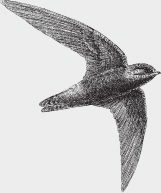
black swift
focus  Swifts
Swifts
Vaux’s swifts nest and roost in hollow trees, and cottonwoods are their favourites. Their eastern cousins, chimney swifts, nest in large chimneys, a habit they picked up quickly after the old-growth forests of eastern North America were liquidated during European settlement. Chimney swift populations have declined drastically in the last few decades as usable chimneys disappear from the landscape. Fears of a similar fate have been expressed about Vaux’s swifts, since the big, hollow trees they need are becoming rarer each year.
Swifts are small, cigar-shaped birds with swept-back wings. They twinkle through the air while their open mouths scoop up small insects. Their closest relatives are the hummingbirds; both groups have legs that are too small for walking or hopping. The other characteristic that ties them together is wing structure. In most birds the main flight feathers are attached to the ulna, or forearm; the feathers attached to the hand of the wing are used for propulsion. In hummingbirds and swifts, the ulna is so short that the feathers attached to it play little role in flight, but the feathers attached to the hand of the wing are used for both propulsion and lift. This structure allows hummingbirds to hover and gives swifts their distinctive twinkling flight pattern.
There are two other species of swifts in the Okanagan Valley. The all-dark black swift is the largest; it nests on rocky ledges beside mountain waterfalls and forages for flying ants over mountain peaks. The white-throated swift nests in deep crevices on the dry, rocky cliffs throughout the valley.